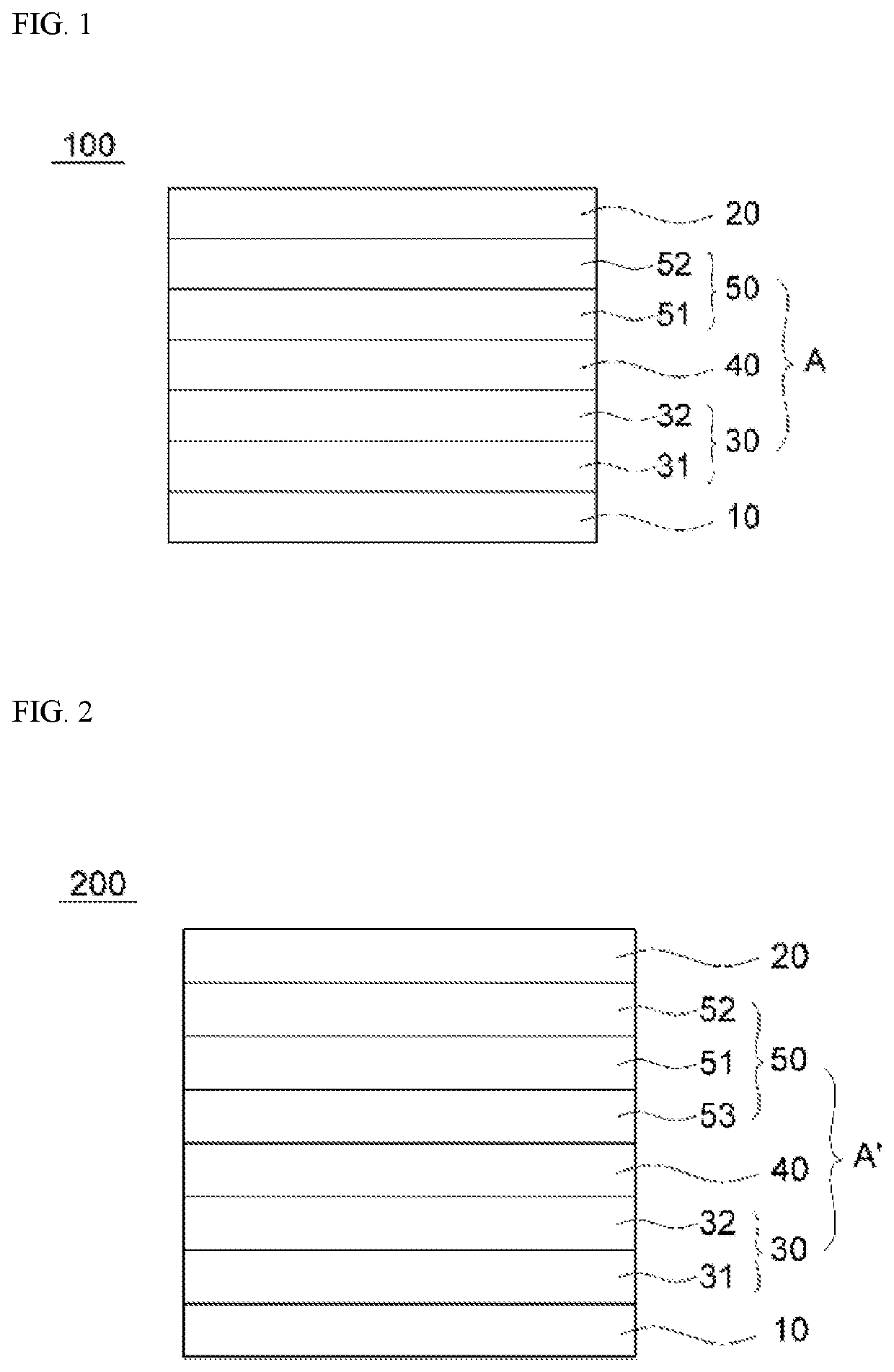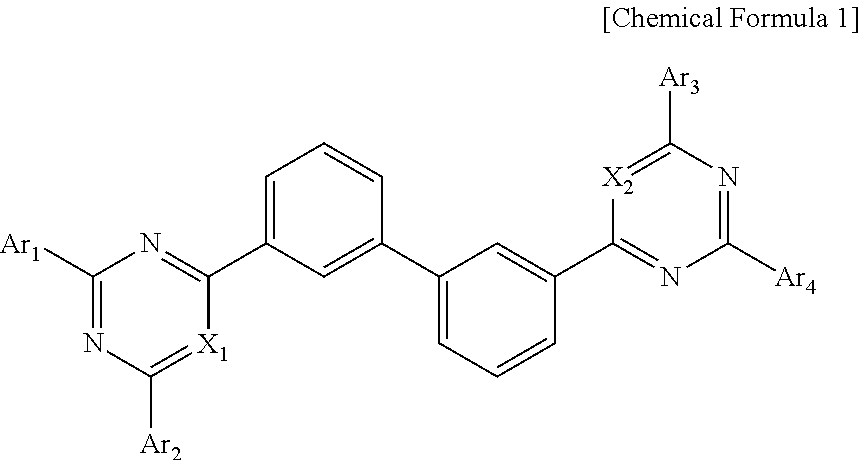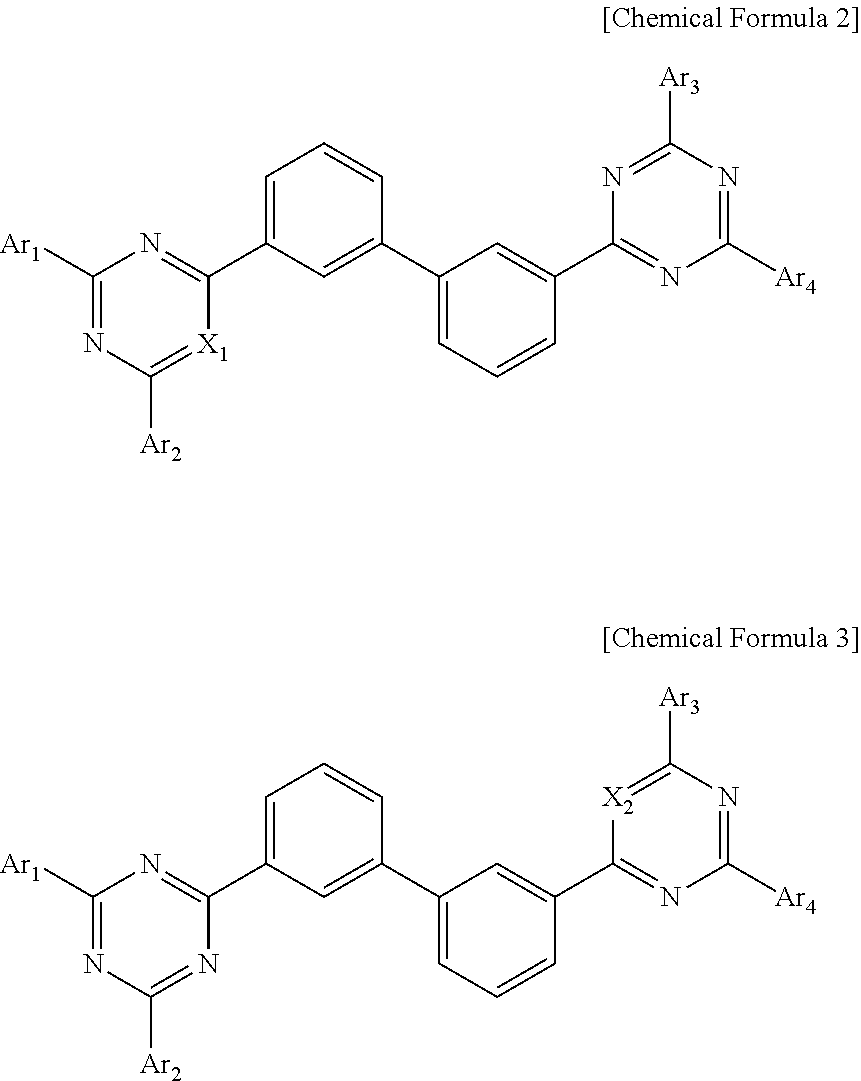Organic electroluminescent device
a technology of electroluminescent devices and organic el, which is applied in the direction of basic electric elements, semiconductor devices, electrical apparatus, etc., can solve the problems of reducing the light emission area, reducing the lifetime, and high efficiency of organic el devices, so as to improve the electron transport ability, reduce the driving voltage, and reduce the effect of luminous efficiency
- Summary
- Abstract
- Description
- Claims
- Application Information
AI Technical Summary
Benefits of technology
Problems solved by technology
Method used
Image
Examples
preparation example
[Preparation Example] Preparation of Compounds ET-01 to ET-21
[0138]Compounds represented by the following ET-01 to ET-21 were prepared as the compounds of the present invention, and their LUMO and EHOMO−ELUMO were measured by methods known in the art, respectively, and are shown in Table 1 below.
[0139]For reference, EHOMO−ELUMO was measured using a UV-Vis spectrophotometer (JASCO, V-500), and LUMO was calculated based on EHUMO-ELUMO by measuring HOMO values using an electrochemical measurement equipment (Potentiostat / Galvanostat, Princeton, 273A) in a cyclic voltammetry (CV) method.
[0140]In such a case, Compounds ET-01 to ET-21 are shown below.
TABLE 1CompoundLUMO (eV)EHOMO-ELUMO (eV)ET-012.803.52ET-022.753.50ET-032.763.58ET-042.783.62ET-052.653.48ET-062.683.42ET-072.573.52ET-082.613.47ET-092.633.41ET-102.723.51ET-112.733.48ET-122.823.38ET-132.793.40ET-142.753.47ET-152.643.52ET-162.663.55ET-172.703.49ET-182.643.57ET-192.713.45ET-202.783.55ET-212.793.50
embodiments 1 to 21
[Embodiments 1 to 21] Manufacturing of Blue Organic EL device
[0141]A glass substrate that had been thin-film-coated with indium tin oxide (ITO) to a thickness of 1500 Å was washed ultrasonically with distilled water. After washing with distilled water was completed, the glass substrate was ultrasonically cleaned with a solvent, such as isopropyl alcohol, acetone and methanol, dried, transferred to a UV OZONE cleaner (Power sonic 405, Hwasin Tech) cleaned for 5 minutes using UV, and then transferred to a vacuum evaporator.
[0142]On the ITO transparent electrode prepared as above, DS-205 (80 nm) / NPB (15 nm) / ADN+5% DS-405 (30 nm) / respective Compounds of Table 1 (30 nm) / LiF (1 nm) / A1 (200 nm) were stack in the order, so that organic EL devices were manufactured.
TABLE 2CompoundThickness (nm)Hole injection layerDS-20580Hole transporting layerNPB15Emissive layerADN + 5% DS-40530Electron transportingET-01~ET-2130layerElectron injection layerLiF1CathodeAl200
experimental example 1
[0147]For each of the blue organic EL devices manufactured in Embodiments 1 to 21 and Comparative Examples 1 to 3, a driving voltage, a current efficiency and a light emission peak at a current density of 10 mA / cm2 were measured and the results are shown in Table 3 below.
TABLE 3ElectronDriving EL Current transportingvoltagepeak efficiencySamplelayer(V)(nm)(cd / A)Embodiment 1ET-013.84548.0Embodiment 2ET-023.54568.9Embodiment 3ET-033.84557.5Embodiment 4ET-044.14537.9Embodiment 5ET-054.04577.2Embodiment 6ET-063.94538.1Embodiment 7ET-073.74557.4Embodiment 8ET-084.04577.6Embodiment 9ET-093.74536.9Embodiment 10ET-103.84557.2Embodiment 11ET-114.14537.5Embodiment 12ET-124.04537.7Embodiment 13ET-134.14577.1Embodiment 14ET-143.84558.1Embodiment 15ET-153.74587.9Embodiment 16ET-163.94577.8Embodiment 17ET-173.74548.2Embodiment 18ET-183.94537.9Embodiment 19ET-193.84527.2Embodiment 20ET-204.04557.8Embodiment 21ET-213.94558.0ComparativeAlq35.44585.5example 1ComparativeT-14.54595.9example 2Comparativ...
PUM
| Property | Measurement | Unit |
|---|---|---|
| LUMO | aaaaa | aaaaa |
| energy difference | aaaaa | aaaaa |
| ionization potential | aaaaa | aaaaa |
Abstract
Description
Claims
Application Information
 Login to View More
Login to View More - R&D
- Intellectual Property
- Life Sciences
- Materials
- Tech Scout
- Unparalleled Data Quality
- Higher Quality Content
- 60% Fewer Hallucinations
Browse by: Latest US Patents, China's latest patents, Technical Efficacy Thesaurus, Application Domain, Technology Topic, Popular Technical Reports.
© 2025 PatSnap. All rights reserved.Legal|Privacy policy|Modern Slavery Act Transparency Statement|Sitemap|About US| Contact US: help@patsnap.com



